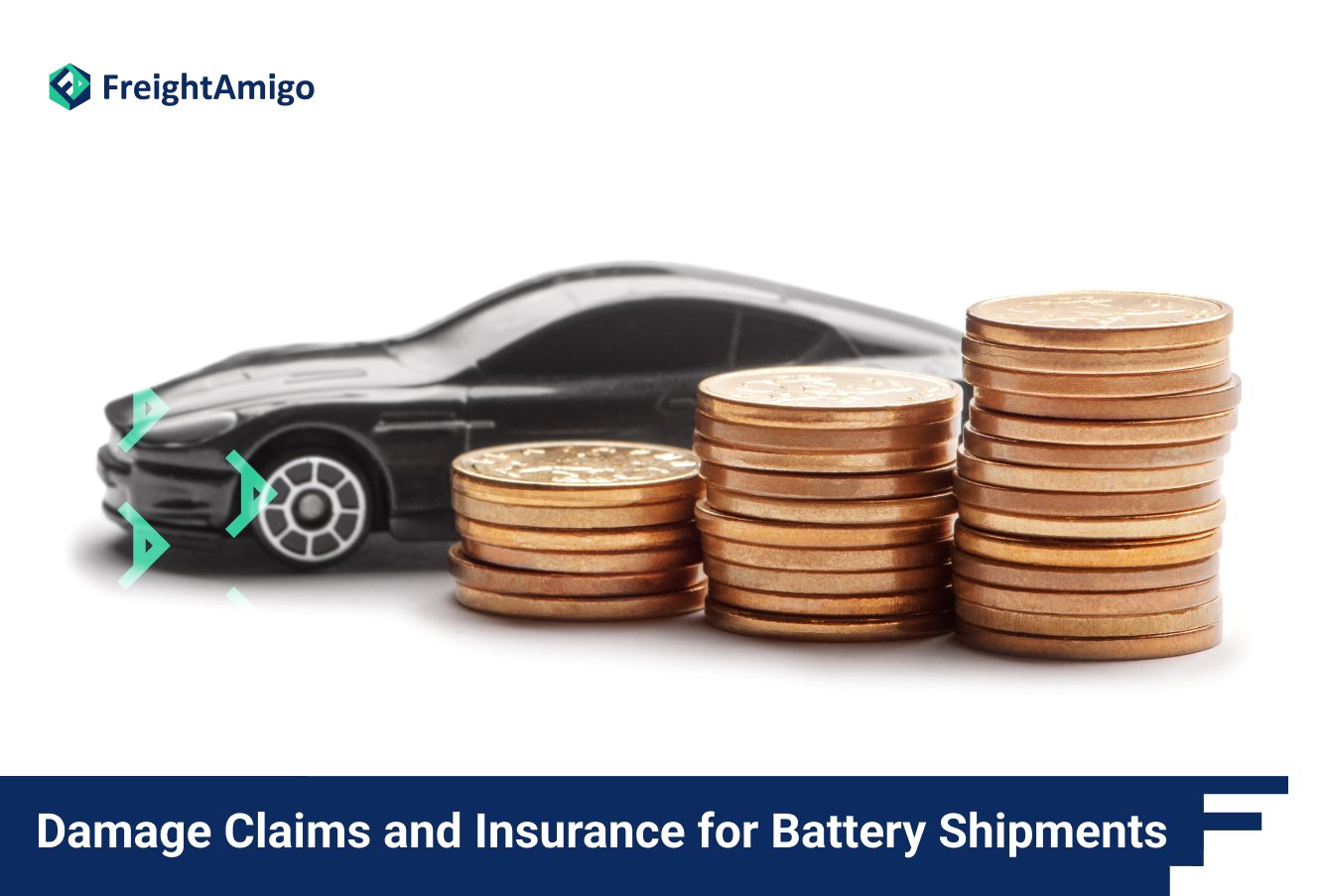Published on: Dec 19, 2023 by Aurora Park – Marketing Analyst at FreightAmigo
Shipping lithium-ion batteries has become increasingly common in today’s global marketplace. These batteries power a wide range of devices, from smartphones and laptops to electric vehicles. However, the transportation of lithium-ion batteries comes with inherent risks, particularly the potential for fires and explosions. As a result, it is crucial for cargo owners and logistics providers to understand the process of filing damage claims and the role of insurance in mitigating these risks.
Want to compare the best Express, Air Freight, Sea Freight, Rail Freight & Trucking rates so as to have better control on cost?
The Risks of Shipping Lithium-Ion Batteries
Lithium-ion batteries are known for their energy density and ability to deliver large amounts of current. However, they also contain a flammable liquid electrolyte, which poses a significant fire hazard. These batteries can overheat, explode, and catch fire, especially when they are damaged or improperly stored, used, or charged.
One of the main causes of lithium-ion battery fires is thermal runaway, a self-sustaining reaction that occurs when the battery’s terminals heat up and the electrolyte liquid begins to boil. If the steam cannot escape the battery, the pressure builds up, causing the battery to swell and potentially leading to an explosion and fire. These fires can be extremely hot and difficult to extinguish, even without an external source of oxygen.
Moreover, the risks associated with shipping lithium-ion batteries extend beyond the safety of the vessels carrying them. Cargo owners may be held liable for injuries or damages caused by a lithium-ion battery fire. This liability highlights the importance of understanding and managing the risks associated with transporting these batteries.
The Need for Shipping Insurance
Given the potential dangers of transporting lithium-ion batteries, it is crucial for cargo owners to secure appropriate insurance coverage. Shipping insurance provides protection against potential liabilities that could arise during the transportation of lithium-ion batteries. This coverage may include loss or damage to the carrying vessel or vehicles, as well as damage to the property or goods belonging to other parties.
However, it is important to note that not all insurance policies cover all potential consequences of a lithium-ion battery fire. Certain aspects, such as resultant pollution, demurrage costs (the cost of delaying the vessel), and general average declarations, may not be covered or may be excluded. Therefore, it is essential for cargo owners to work closely with their brokers or insurance advisors to ensure that their policies adequately address the risks associated with lithium-ion battery shipments.
Managing Risks and Filing Damage Claims
To effectively manage the risks associated with shipping lithium-ion batteries, cargo owners and logistics providers should take proactive measures. Here are three key steps to consider:
- Confirm Insurance Coverage
The first step is to work closely with your broker or insurance advisor to confirm whether your insurance policy covers the potential liabilities associated with lithium-ion battery shipments. It is crucial to review the policy carefully to determine which risks are covered and which are excluded. Some consequences, such as pollution or demurrage costs, may require additional coverage or specific endorsements. By understanding the scope of your insurance coverage, you can ensure that you are adequately protected in the event of a lithium-ion battery fire.
- Accurate Declaration and Packaging
When shipping goods containing lithium-ion batteries, it is essential to accurately declare the presence of these batteries to carriers. The description of your cargo should specifically mention the inclusion of electric vehicles or goods containing lithium-ion batteries. This accurate declaration helps promote safer carriage of dangerous goods and protects you against accusations of misdeclaration. It is also crucial to package these goods in compliance with the International Maritime Dangerous Goods (IMDG) Code. Proper packaging ensures that the batteries are handled with the appropriate care and reduces the risk of fire or other incidents during transportation.
- Consider Cargo Owner’s Liability Insurance
In addition to traditional general liability insurance and cargo insurance, cargo owners should consider cargo owner’s liability insurance. This type of insurance fills the gaps between general liability and cargo insurance policies and provides additional protection. Cargo owner’s liability insurance offers coverage for third-party damages and their consequences, offering comprehensive insurance protection for prudent cargo owners. By considering this additional coverage, cargo owners can eliminate ambiguity and mitigate potential risks associated with lithium-ion battery shipments.
Progress in Damage Claims and Insurance
The shipping industry has made progress in addressing the risks and challenges associated with shipping lithium-ion batteries. Manufacturers of lithium-ion batteries are subject to industry standards and testing requirements, which provide guidance on how to test and validate batteries’ safety. Additionally, the UN Manual of Tests and Criteria sets out design tests that manufacturers must complete and provide proof of compliance through Test Summaries reports.
Regulators and organizations are also working to refine and update safety regulations to reflect the evolving landscape of lithium-ion battery technology. For example, there have been discussions about adding lithium-ion batteries to the list of high-risk products that require mandatory third-party approval. This would involve independent testing and certification of batteries before they can be sold in certain markets.
Furthermore, training and awareness programs are being developed to educate staff and seafarers about the safe handling, storage, and firefighting techniques specific to lithium-ion batteries. Early detection systems, such as thermal scanners, gas detectors, heat/smoke detectors, and CCTV cameras, are being utilized to aid in identifying potential hazards during transportation.
Conclusion
Shipping insurance plays a vital role in managing the risks associated with transporting lithium-ion batteries. With FreightAmigo, cargo owners can ensure that their policies adequately cover the potential liabilities and consequences of a lithium-ion battery fire. Accurate declaration and compliance with packaging regulations are essential to promote safe carriage and reduce the risk of incidents. Considering cargo owner’s liability insurance can provide additional protection and fill gaps in existing coverage.
As the shipping industry continues to navigate the challenges of transporting lithium-ion batteries, ongoing efforts in testing, regulation, training, and awareness are crucial. By staying informed and implementing best practices, cargo owners and logistics providers can mitigate risks, protect their assets, and contribute to the safe transportation of lithium-ion batteries.
Easy Insurance Issuance to Shipments with just 1 Click
With FreightAmigo, you can insure your cargo with just 1-click. You don’t have to deal with a cumbersome cargo insurance process anymore. Enjoy a swift and seamless digitally-driven experience that can be customized for greater cost-effectiveness.
There are different options for cargo transportation. If you want to choose the most convenient and suitable solution, it is best to have the full support of logistics experts! If you are planning to ship goods overseas, please go to the FreightAmigo page for inquiries.
===
Read More:
How to Ship Car Batteries | A Comprehensive Guide
Smooth and Secure Shipping Methods for Car Batteries
How to Ensure a Stress-Free Car Shipping Experience
Car Batteries Shipping Regulations : All You Need to Know
===
If you have any inquiries on logistics/supply chain, feel free to contact FreightAmigo now:
Hotline: +852 28121686
WhatsApp: +852 27467829









































